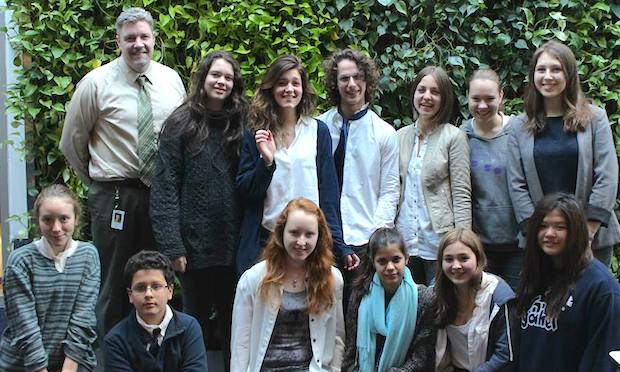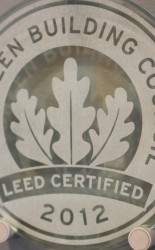Over the last couple of months, the entire Lycée Français de New York (LFNY) community has just been buzzing about the Print-Less movement! Indeed, over a five-week period Secondary students were competing to see which grade could reduce their paper consumption the most. The school-wide faculty got involved just this past week by participating in the Print-Less Challenge that invites teachers to challenge themselves in scaling down on paper usage, particularly within printers and copying machines.
The 2014 Environmental Taskforce team consists of 13 students from 6 to 12 grade as well as five staff.
This idea was initially conceived within a meeting that conjoined the student and faculty Environmental Task Force, which promotes more environmentally-conscious decisions within the LFNY, at the end of last summer. A project this monumental required many months of planning and communication to coordinate as Heads of Departments of both secondary and primary, the Head of School and the IT Department all had to be on board. While it was not new for the school to be participating in an environmental challenge of some sort, it was the first time the Environmental Task Force (ETF) started from scratch and planned every detail of it.
Looking at who is printing less overtime
The Print-Less Competition, only involving students in grades 6-12, rolled out upon returning from February break. It essentially encouraged grades to compete against each other to see who could decrease their printing the most. Since this particular project was spearheaded solely by the student ETF, we felt it necessary to utilize our unique perspective of this competition being ‘by the students for the students’. Since we know that a 6th grader doesn’t necessarily print as much as a Junior, we wanted to give each grade an equal opportunity to make a serious change. As a result, we determined that the winning grade was not chosen based on who printed the least sheets in total but rather who consistently printed less.
Indeed, thanks to the IT Department’s software that tracks how many pages are printed per student account, we secretly monitored all students’ printing throughout the month of January to calculate every grade’s own weekly baseline average. Once the competition started, we compared each week’s data of sheets printed to the baseline and determined whether they increased or decreased printing.
360 trees worth of paper
Although the search to find the greenest grade was well worth the effort, its competitive nature more of a guise for the ETF to raise awareness on paper consumption within the school. As a result, throughout the five weeks of competition, we went through advisories to present the environmental impacts of excessive paper usage and tips on how to print less. Over an entire year, the Lycée uses, on average, 3 million sheets, the product of 360 trees. And while the Lycée does supply its paper from managed forests, creating one sheet of paper requires oft-forgotten resources such as energy, bleach and water. That is why it is important to curb consumption whenever possible: by printing double-sided, printing on the back of unwanted scrap paper, reducing margins and utilizing the Lycée’s developed online assignment hand-in resources such as GoogleDocs and Haiku.
The LFNY is LEED-certified since 2012.
Over those five weeks though, the ETF realized that student’s paper consumption wasn’t as alarming as all faculty’s. In fact, while students rounded out to an average of 900 sheets per week, the faculty fluctuated between 28,000 to 48,000 sheets a week. The participation of all school staff, therefore, was paramount.
This time with the help of the faculty ETF led by Terrence Kennedy, the school’s Director of Facilities and the student ETF’s very own adult supervisor, a new plan was set in motion to involve teachers. Finding a way to desensitize the subject, however, was a hurdle to pass. We did not want teachers to need to justify what they print out as printing documents and packets are of course expected. This was rather to help teachers make more informed printing decisions and reducing whenever possible.
Using statistics to empower the user
Our beloved competition was consequently renamed to the Print-Less Challenge which no longer put individuals at odds with each other, but rather encouraged teachers to challenge themselves. After the first week, each teacher received their own personal printing statistics to help them better visualize their own impact in the hopes to reduce printing by 10% over this two-week period. The teachers with the biggest reduction by the end of the May 3 week will be rewarded for their environmentalism with prize packages.
This ETF-sponsored project, though, is one of many that were completed this year. Indeed, going quite literally at the source of printing’s resources, the ETF participated in a MillionTreesNYC-sponsored event to plant 20,000 trees and 2,000 shrubs early morning in Rockaway Community Park, Queens. Moreover, earlier in the school year, the Secondary competed in the Green Schools Alliance’s own Green Cup Challenge, which measured recycling efficiency (how often materials were placed in the proper bin).
The Lycée Français de New York’s solar panels, on the rooftop of the Primary School.
Before the Green Cup Challenge, 21% of recycling bins within the school were filled with the proper recyclables. After many presentations, posters, stickers and announcements, 4 weeks later, the school had an astounding 79% of correct recycling bins and these results keep on rising as the ETF has continued to sporadically check bins throughout the year. Beyond the Print-Less movement, the ETF has just recently begun composting kitchen scraps from the school’s food supplier, Flik. Evidently, the first half of 2014 has definitely been green!
All of this environmentalism, however, has only been possible thanks to the LFNY’s commitment to sustainability. Did you know that the school has 22 solar panels, which can power up to 3 or 4 classrooms, located on the roof? And that it is currently working with engineers to install a fully functional wind turbine to produce even more alternative energy resources? Or that the LFNY aims to achieve carbon neutrality by 2020? No wonder it was awarded the much-coveted green-building certification LEED (Leadership in Energy & Environmental Design)! Hopefully the LFNY’s engagement in the environment can serve as inspiration to continue efforts to be greener, beyond this year’s wonderful Earth Day.
Photo: Degree.
About the Author :
Rebecca is a Y12 (Terminale) student at the LFNY. She is the Co-Leader of the school’s Environmental Task Force (ETF).




